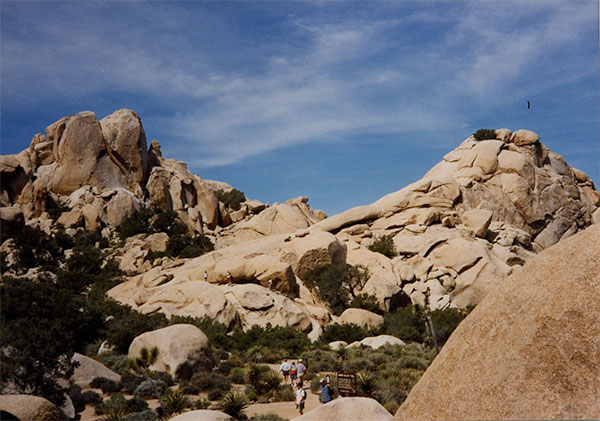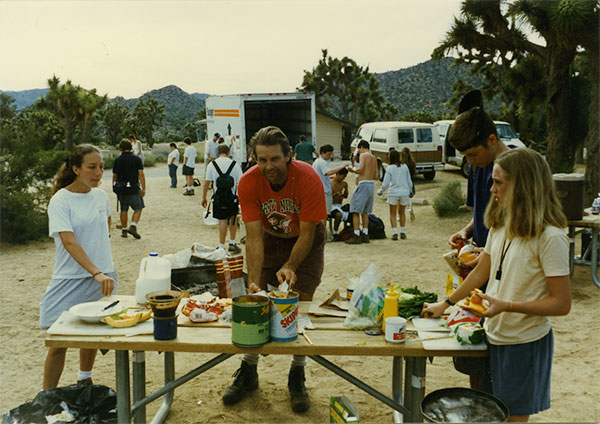Annual junior trip to Joshua Tree coming to an end

Sunburns, rocks, and tradition: These defining parts of Joshua Tree may be left in the desert dust as Urban explores other options for the annual junior class trip.
When Urban was smaller, all students went on a trip in October, with a different location each year. In 1983, Point Reyes was identified as the location for the trip. But seven years later, Urban grew to about 240 students, which was too big for an all-school trip. Thus, the exclusively junior trip was created.
“We thought, ‘Let’s put all of the resources of the all-school trip into junior year because junior year is critical for people to find who they are,’” said Richard Lautze, former director of outdoor trips and current math teacher at Urban.
Although the trip has evolved, it retains its original purpose. “Our goal is to have the class start their senior year with a collective sense of accomplishment from successfully completing the Joshua Tree trip, strengthened relationships with each other, and a readiness for their new role as leaders of the student body,” said Rachel Fristedt, the current director of outdoor trips.
Even with these intentions, students’ experiences and opinions vary. The class of 2015 was the most recent class to go to Joshua Tree, and while some agree that experiencing the harsh conditions is important, others did not find the social goals as successful.
“It didn’t really impact me that much,” said Shmar Williams (‘15). “I just didn’t like being in the heat and I don’t think that I really bonded that much with the class as (much as) was advertised.”
Molly Carlton (‘15) said, “It wasn’t really bad or good … people just split off into their friend groups and there wasn’t a lot of bonding between people who weren’t already friends.”
Others had very positive experiences while in Joshua Tree and thought the class bonding aspect of the trip was successful. “I thought Joshua Tree was hella tight,” said Adam Goldstein (‘15). “It led to a lot of great bonding experiences in the grade … because I usually don’t see a lot of people in my grade all at the same time. I really enjoyed bouldering, and the ending campfire with the ritual was cool … very old-school Urban.”
Lautze emphasized the importance of the harsh conditions in Joshua Tree, located in between Riverside County and San Bernardino County in Southeast California. “The idea of going to the desert where you don’t have showers and you don’t have a lot of water … everyone feels a certain amount of discomfort, which is good. It’s almost a social justice issue. Like, if we’re going to go somewhere, let’s go somewhere that’s hard for everybody,” Lautze said. “There’s no cell service and … we have to look to each other for support and I think that really brings people together.”
When asked what she would change about junior trips, Shane Ortiz (‘15) responded, “Nothing. I think (Urban juniors) all have to suffer through it and learn from it.”
Students noted that they were more appreciative of the stability and ease of being at home after living in Joshua Tree’s unique terrain. “Being sick at Joshua Tree, though really hard in the moment, definitely helped me get through being sick at school, for my SATs, for my college tours, etc.,” Emily Miller (‘15) wrote in an email to Legend staff. “It’s much easier to deal with a stuffy nose and a sore throat while doing homework when you compare it to dealing with it while hiking in 100-degree weather in Joshua Tree with only scratchy toilet paper to use on your chapped nose.”
Hannah Murphy (‘15) disagreed that it was necessary to go to Joshua Tree to have the life-changing experience originally sought after when the trip was established. “Being such a green school, it’s kind of ridiculous that we would go so far when there are closer places like Yosemite,” said Murphy. “Literally anywhere closer would’ve had the same effect.”
Urban faculty have been aware of the environmental impact of traveling to Joshua Tree for years, but recent disciplinary issues have prompted more serious discussions about the pros and cons of the trip. Other limitations include the distance of the trip, which makes logistics and planning more difficult, the competitiveness for securing a place to camp for over 100 people, and finding extra help from professionals who are willing to go all the way to Joshua Tree to work.
Because of the extent of the trip’s shortcomings, Urban faculty, led by Rachel Fristedt, are figuring out how to change the trip while still maintaining its core goals. “We are in the planning process, (which) requires collaboration between the administration, faculty, and staff,” said Fristedt. “One consideration is going to Point Reyes.”


